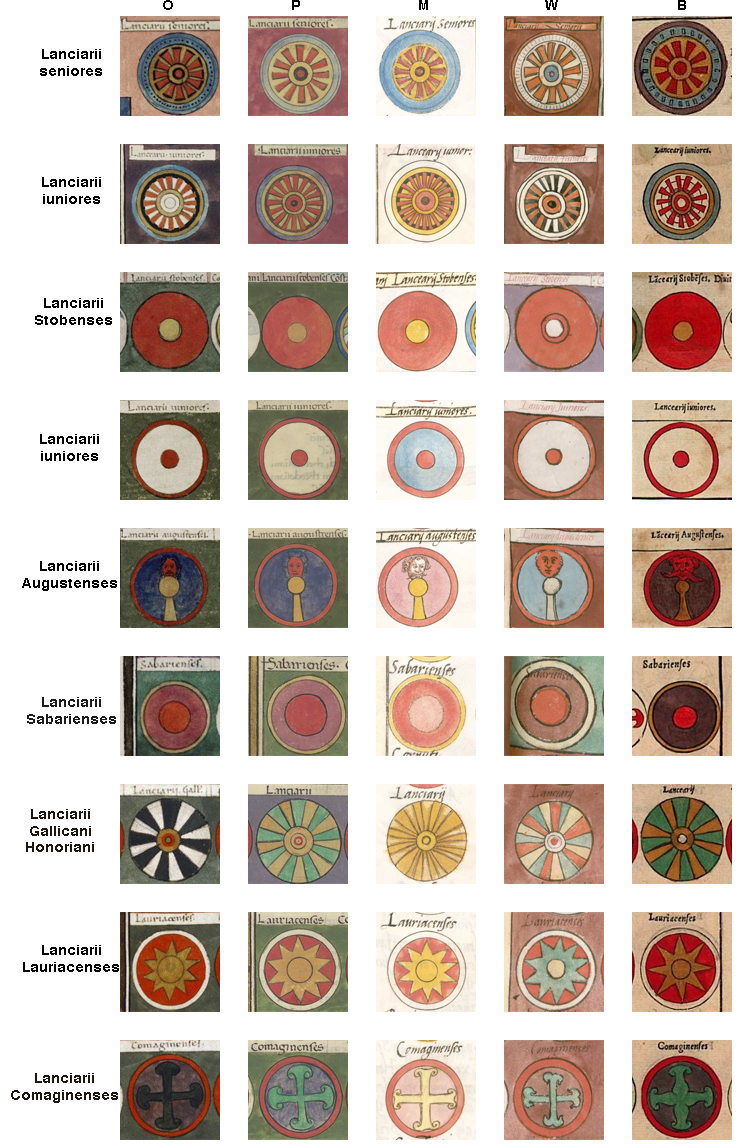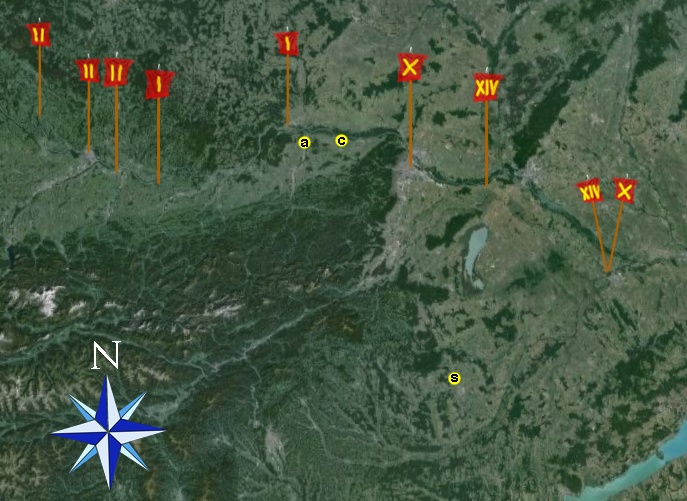
This page created 1 January 2004, and last modified: 18 July 2015 (commentary and map regarding name derivations added)

Nine units of lanciarii are noted in the Notitia. In the east (the numbers in front of the names refer to Ingo Maier's numbering scheme):
9.17 Lanciarii seniores, a palatine unit under the Magister Militum Praesentalis Iand in the west:
12.21 Lanciarii iuniores, a palatine unit under the Magister Militum Praesentalis II
18.22 Lanciarii Stobenses, a comitatenses unit under the Magister Militum per Thracias
21.20 Lanciarii Augustenses, a comitatenses under the Magister Militum per Illyricum
21.22 Lanciarii iuniores, another comitatenses unit under the Magister Militum per Illyricum
98/9.28 Lanciarii Sabarienses, a palatine unit in the Magister Equitum's Gallic commandAll appear to be legionary units, although this is not explicit for the two pseudocomitatenses units. Exactly what sort of legionary units, however, is unclear. Their title lanciarii (or lancearii) would imply they were armed with a lancea (whence our modern 'lance'), usually meaning a spear equally suitable for throwing or thrusting, but that does not necessarily follow; nor does it automatically imply other legionaries did not carry lanceae. There is evidence that in the 3rd century at least, at least some legionary lanciarii were armed with what are better termed multiple light javelins rather than throwing spears; however, it is equally clear from other evidence that more "normal" legionaries could also be called lanciarii, at least in the 2nd century; see my (now rather dated) discussion. We even hear of mounted lanciarii, as attested by inscriptional evidence (AE 1981, 777) where the gravestone of one Aurelius Gaius describes him (in Greek) as an "ippeus lankiaris".
98/9.113 Lanciarii Gallicani Honoriani/Lanciarii Honoriani Gallicani, a comitatenses unit in the Magister Equitum's Gallic command
98/9.133 Lanciarii Lauriacenses, a pseudocomitatenses unit under the Comes Illyricum
98/9.134 Lanciarii Comaginenses, another pseudocomitatenses unit under the Comes Illyricum.

Shown above are the shield patterns of these units. A visual relationship between the Lanciarii seniores and the first unit of Lanciarii iuniores (under the Magister Militum per Illyricum), is immediately apparent.
The Lanciarii Augustenses, Lanciarii Sabarienses, Lanciarii Lauriacenses, and the Lanciarii Comaginenses all have names deriving from garrison stations under the Dux Pannoniae primae et Norici ripensis. Since there are four limitanei legions under the Dux, it would appear likely that each of these four units is derived from one of the four legions under the Dux. Since Legio II Italica appears to have been headquartered at Lauriacum, it is almost certainly the progenitor of the Lanciarii Lauriacenses. Which of Legio I Noricum, Legio X Gemina and Legio XIV Gemina correspond to the other three units is less obvious.

However, looking at the locations of the legionary detachments stationed along the Danube in what is now Austria gives a reasonable indication that the Lanciarii Augustenses is most likely to derive from Legio I Noricum, since Augustiana ("a" in the above map) is most closely positioned to a detachment of that legion, while the Lanciarii Comaginenses is most likely to derive from Legio X Gemina, since Comagina ("c" in the above map) is most closely positioned to a detachment of that legion, leaving the Lanciarii Sabarienses to Legio XIV Gemina, which is most closely position to Savaria ("s" in the above map).

Return to the Notitia index page.